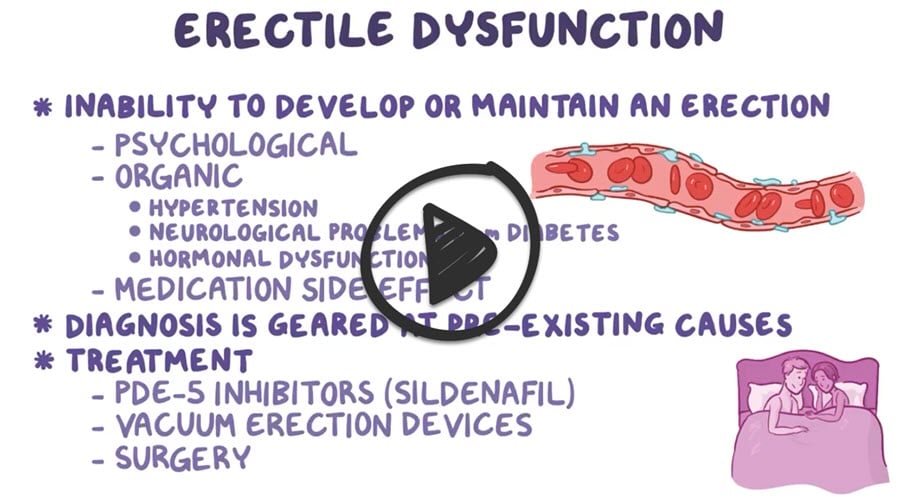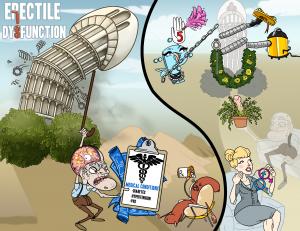Patient will present as → a 60-year-old man who presents to your clinic for evaluation of erectile dysfunction. His wife died 5 years ago and he would like to start dating again. He denies having any life stressors. He reports having no morning or night-time erections. His past medical history includes hyperlipidemia managed with medication and pre-diabetes managed with an active lifestyle and diet.
To watch this and all of Joe Gilboy PA-C's video lessons you must be a member. Members can log in here or join now.
Erectile dysfunction is the recurring inability to achieve and maintain an erection sufficient for satisfactory sexual performance
- It is thought that up to half of all men in the United States between the ages of 40 and 70 have some form of erectile dysfunction. Prevalence increases with age
Risk factors
- The most important risk factors are those that contribute to atherosclerosis (e.g., HTN, smoking, hyperlipidemia, diabetes)
- Medications—antihypertensives (may indirectly lower intracavernosal pressure by virtue of lowering systemic BP)
- Hematologic—sickle cell disease
- History of pelvic surgery or perineal trauma
- Alcohol abuse
- Any cause of hypogonadism/low testosterone state, including hypothyroidism
- Congenital penile curvature
The major organic causes of ED are
- Vascular disorders
- Neurologic disorders
- Psychological
- Hormonal
- Drugs
The most common vascular cause is atherosclerosis of cavernous arteries of the penis, often caused by smoking and diabetes. Atherosclerosis and aging decrease the capacity for dilation of arterial blood vessels and smooth muscle relaxation, limiting the amount of blood that can enter the penis. Veno-occlusive dysfunction permits venous leakage, which results in an inability to maintain an erection.
- Priapism: usually associated with trazodone use, cocaine abuse, and sickle cell disease, may cause penile fibrosis and lead to ED by causing fibrosis of penile veins that interfere with drainage.
- Neurologic causes: Include stroke, partial complex seizures, multiple sclerosis, peripheral and autonomic neuropathies, and spinal cord injuries. Diabetic neuropathy and surgical injury are particularly common causes.
- A psychological cause should be suspected in young healthy men with abrupt onset of ED, particularly if onset is associated with a specific emotional event or if the dysfunction occurs only in certain settings. A history of ED with spontaneous improvement also suggests psychologic origin (psychogenic ED). Men with psychogenic ED usually have normal nocturnal erections and erections upon awakening, whereas men with organic ED often do not.
- Complications of pelvic surgery (eg, radical prostatectomy [even with nerve-sparing techniques], radical cystectomy, transurethral resection of the prostate, rectal cancer surgery) are other common causes. Other causes include hormonal disorders, drugs, pelvic radiation, and structural disorders of the penis (eg, Peyronie disease). Prolonged perineal pressure (as occurs during bicycle riding) or pelvic or perineal trauma can cause ED.
- Any endocrinopathy or aging associated with testosterone deficiency ( hypogonadism) may decrease libido and cause ED. However, erectile function only rarely improves with normalization of serum testosterone levels because most affected men also have neurovascular causes of ED.
Detailed history and examination, including a digital rectal examination and neurologic examination. Assess for signs of PAD
- Laboratory tests—Obtain a CBC, chemistry panel, fasting glucose, and lipid profile
- If there is hypogonadism or loss of libido, order serum testosterone, prolactin levels, and thyroid profile
- Nocturnal penile tumescence—If normal erections occur during sleep, a psychogenic cause is likely. If not, the cause is probably organic.
- Consider vascular testing—Evaluate arterial inflow and venous trapping of blood. Tests include intracavernosal injection of vasoactive substances, duplex ultrasound, and arteriography
- Psychologic testing may be appropriate in some cases
Treat the underlying cause. Address atherosclerotic risk factors (weight loss and smoking cessation in all patients)
First-line treatment is with phosphodiesterase inhibitors such as sildenafil citrate (Viagra), which acts by increasing cGMP levels causing increased nitric oxide release and penile smooth muscle relaxation. It can be taken 30 to 60 minutes before anticipated intercourse. It is contraindicated with the use of nitrates because together they can cause profound hypotension.
Phosphodiesterase 5 inhibitors:
- Sildenafil (Viagra) take on empty stomach - take one hour before intercourse - can be effective 6 or 8 hours
- Tadalafil (Cialis) - may take two hours to work and can be effective for 24 to 36 hours
- Vardenafil (Levitra) - can be taken with food (avoid fatty foods) - take one hour before intercourse - can be effective 6 or 8 hours
May cause PRIAPISM – remember the commercials = erection longer than 4 hours. Treat with ice and stair walking, may use Sudafed
- Intracavernosal injections of vasoactive agents (patient learns to self-administer)
- Vacuum constriction devices are rings placed around the base of the penis that enhance venous trapping of blood; they may interfere with ejaculation
- Psychologic therapy may be indicated to reduce performance anxiety and address underlying factors that may be causing or contributing to erectile dysfunction
- Hormonal replacement (e.g., testosterone) in patients with documented hypogonadism
- Penile implants for patients who have not responded to the above
 Osmosis Osmosis |
|
 |
 Erectile dysfunction is the inability to achieve or maintain an erection for intercourse. Causes of erectile dysfunction include testosterone deficiency, medical conditions, medications, and psychological factors. Drug therapy includes phosphodiesterase type 5 inhibitors to relax smooth muscles for increased blood flow to the corpus cavernosum. Vacuum constriction devices, intraurethral devices, and penile implants may be used to achieve an erection. Sexual counseling should include the patient’s partner and begin prior to medical treatment.
Erectile dysfunction is the inability to achieve or maintain an erection for intercourse. Causes of erectile dysfunction include testosterone deficiency, medical conditions, medications, and psychological factors. Drug therapy includes phosphodiesterase type 5 inhibitors to relax smooth muscles for increased blood flow to the corpus cavernosum. Vacuum constriction devices, intraurethral devices, and penile implants may be used to achieve an erection. Sexual counseling should include the patient’s partner and begin prior to medical treatment.
| Erectile dysfunction | Play Video + Quiz |
| Nitroglycerin | Play Video + Quiz |
| Selective Serotonin Reuptake Inhibitor (SSRI) Overview | Play Video + Quiz |
Question 1 |
Enalapril (Vasotec) Hint: This ACE inhibitor is not contraindicated with sildenafil. Although both medications can lower blood pressure, proper monitoring can manage potential interactions. | |
Albuterol Hint: This medication, a beta-agonist for asthma, does not have a contraindicated interaction with sildenafil. Its action is primarily on the bronchi, not the vasculature affected by sildenafil. | |
Finasteride (Proscar) Hint: Used for benign prostatic hyperplasia, finasteride does not have an adverse interaction with sildenafil. It works by inhibiting the conversion of testosterone to DHT and does not interfere with sildenafil's mechanism. | |
Nitroglycerin | |
Metformin Hint: Primarily used for the management of type 2 diabetes, metformin does not have a known adverse interaction with sildenafil. It is not contraindicated and does not contribute to the risk of severe hypotension associated with nitroglycerin and sildenafil use. |
Question 2 |
Trauma | |
Endocrine disorders | |
Vascular diseases | |
Respiratory diseases |
Question 3 |
Cardiovascular-related ED Hint: This is a common cause of ED, as cardiovascular health directly affects blood flow, making this a likely cause rather than the least likely. | |
Smoking-related ED Hint: Smoking is a well-known risk factor for ED due to its impact on vascular health, making it a more common cause. | |
Medication-induced ED Hint: Many medications have side effects that can include ED, making this a relatively common cause. | |
Pure psychogenic ED | |
ED related to hormonal imbalances Hint: Hormonal factors, such as low testosterone levels, can also lead to ED, making it a more common cause compared to purely psychogenic ED. |
Question 4 |
Prostate-specific antigen (PSA) screening | |
Lipid profile | |
Hormonal blood testing | |
Direct injection of prostaglandin E1 (PGE1) |
Question 5 |
Androgen | |
Phosphodiesterase-5 (PDE5) inhibitors | |
Vascular endothelial growth factor (VEGF) | |
Dopamine receptor antagonists | |
Psychotherapy |
|
List |
References: Merck Manual · UpToDate


 Lecture
Lecture
